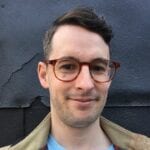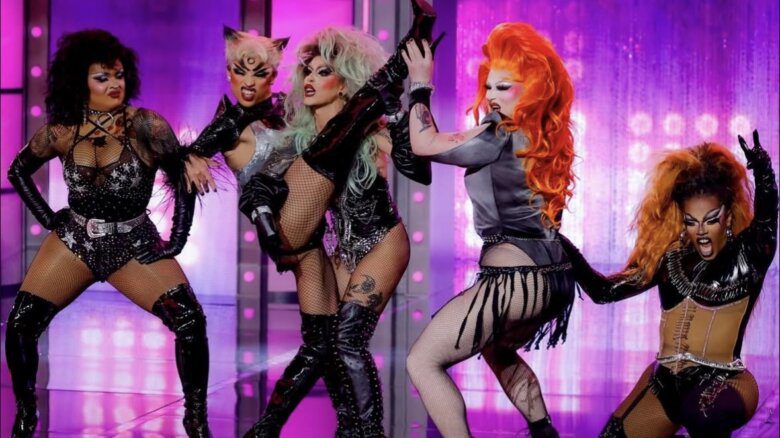Uschi Tala strikes a balance between darkness and light through their connections to sacred traditions. Raised on a remote farm as a member of the Hare Krishna movement, they have now found a home in the traditional territory of the Sinixt First Nation in British Columbia’s Slocan Valley, near the community of Winlaw. On their debut album, Between the Veil, the queer, gender-fluid musician weaves elements of experimental hip-hop with gothic folk and enchanting ambient soundscapes.
Tala’s work draws on the breathtaking beauty of the natural world that surrounds them, opening a portal into unseen realms and supernatural forces. Through parallel practices as a songwriter, poet and short story author, they are attempting to create a form of folklore where darkness is embraced in order to better understand the pain that haunts our lives. This is vividly showcased in the pair of videos that accompany Tala’s songs “Don’t Heavy On” and “Warriors of Darkness, Wielders of Light,” setting their music to epic fantasy sequences filmed in the gorgeous environments of the Kootenay Rockies.
While Tala typically lives off the grid, we connected for an enlightening conversation peppered with stories about Tupac, Angelina Jolie and how nature turns them on.
What was your process like to arrive at the kind of music you make now?
The story starts pretty far back. I was raised on a Hare Krishna farm in the middle of nowhere with no electricity or running water. The religion is from Eastern India, so we learned bhajans when I was younger. My first instruments were a mridanga and a harmonium, and I learned to sing in Sanskrit. “Tala” is a Sanskrit word that means a complicated rhythmic pattern.
When I was a young teenager, I started learning how to play guitar and was totally self-taught. Then I brought the rhythmic stuff that I learned with the mridanga to the guitar. I started tuning it open and doing a lot of percussive playing. From there I started beatboxing, doing poetry and playing keyboard. I played folk music for years and have a couple of albums that I never really released. Then I bought a looper and started putting it all together.
How did you become interested in rapping?
This is funny. On the Hare Krishna farm, we were quite isolated and had strict rules. My brother was many years older than me and he used to take me driving in his Volvo. He was obsessed with Tupac, so I learned all the songs and rapped along to them with him. That was my first influence for sure.
Can you tell me about the traditional territory where you live now in the Slocan Valley? What is your personal relationship with the area?
I originally started coming here around five years ago. My brother moved out and had some kids, so that was the first thing that brought me to the area. I first started working at the Hare Krishna restaurant, then left and came back, and now I’ve been here for about two years.
I’ve been getting to know Marilyn James, the Sinixt Elder on the land, and we’ve been doing some frontline work with her around water protection and the pipelines. All of Winlaw is considered Sinixt territory, but they were declared “extinct” so the hydro plant could move in. Being raised on the farm, a lot of my close family members were Indigenous, so I feel it’s really important to do anti-racism and decolonization work. It’s a lifelong process.
That work also ties into the album. You’ve described one of its themes as the struggle between man and nature as a metaphor for colonial violence toward marginalized people. What connections did you find?
The Indigenous way of life is all about living and working in harmony with nature. On the other side of that is the machine, the city and the patriarchy fighting against it. It doesn’t split directly down the middle, obviously, but I feel that duality is there.
I understand you’ve been living off the grid without phone access for the most part. Is that on purpose to remove yourself from the outside world?
Sometimes! We don’t have cell phone access in the Slocan Valley, so you can do internet calling but it’s very hit and miss. Every time I’ve owned a cell phone I’ve been really bad at answering it, that’s for sure. I have my own place out in the woods so I can basically just write, make music and be as loud as I want. I like to be isolated and spend a lot of time alone working on my stuff, so it’s quite perfect for that.
You’ve also said that you did a lot of important self-work while working on this album. Can you tell me a bit more about that?
Do you want the short version or the long version? [laughs] I’ll try to condense it. When I first moved here, I was quite rebellious and wild. I liked to party and have a lot of lovers. I was just ignoring myself, or scared of myself, I think. Three years ago, I stopped seeing everyone and started to look inside. I realized that I wasn’t that scary and needed to do some work to love myself. I started going for walks all the time, doing yoga, seeing counsellors and doing energy healing with craniosacral work to begin to unlayer the trauma that I had buried. I started looking at my traumas and triggers to figure out how I can evolve.
Did that healing process help you get in touch with your queer and non-binary identity?
I would say the non-binary part for sure, but I knew I was queer at a very young age, probably 12 or 13. It was hard on the Hare Krishna farm because they don’t really support that kind of thing. I thought there was something wrong with me because I didn’t feel attraction toward boys. Then I watched this movie called Gia and realized girls were an option! [laughs] I started to feel fluttery inside and realized this is what other people were talking about. It blew my mind and I felt amazing. Then I just went from there.
Your song “Naturedisiac” is described as a love letter to the natural areas and sacred spaces where you live.
It just feels so lush here, especially in the Kootenays. There’s so much green and you can feel the clean water in the air. That song was inspired by driving Highway 1 to Vancouver, when you pass through [the town of] Hope and get those huge mountains with moss. When it’s misty and rainy I start to get turned on by nature, as strange as that sounds. [laughs] I’ll get chills and sometimes be brought to tears. You can feel, taste and smell the beauty. It’s everywhere and really overwhelming.
Can you tell me a bit about the two videos you’ve released for songs from this album? They seem to tie together the artistic world you’re creating with heroic fantasy characters clashing against some kind of supernatural evil. Is that an accurate reading?
Yes, you got it. [laughs] The first one for “Don’t Heavy On” would definitely be an externalized version of what we were talking about when I returned to the valley to work on my trauma and demons. I’d started writing short stories as well and was really upset by the fairy tale world with lightness winning and conquering the darkness. There’s no regard for the connection between the two, but I believe we need to know our darkness to really understand our light. That story is about me trying to lure my demons in instead of running from them. When I cut my hand [in the video] the thread represents blood. At the end, out pops the person in the red coat as a representation of Little Red Riding Hood. It’s about embracing your darkness so you can heal your childhood traumas and move forward.
The second video for “Warriors of Darkness, Wielders of Light” is based on things that have been happening around us, like the uprisings at the Unist’ot’en Camp [where Indigenous people are protesting proposed pipeline projects]. People were gathering in the streets, rising up for Black Lives Matter and taking a stand against police brutality while COVID-19 shut things down and separated us. It came out of those frustrations. There’s a warrior going through all of these battles before surrendering at the end. These shadow creatures are transformed into the elements and they have a face off. It was trying to get back to what we should be focusing on to ensure our survival.
Is there some kind of guiding narrative tying the videos together or is each one a standalone project?
They’re two different things but they definitely have themes that tie them together. For us to show up in the world and help each other, we need to look at ourselves and unlayer so we can really be of service.


 Why you can trust Xtra
Why you can trust Xtra


